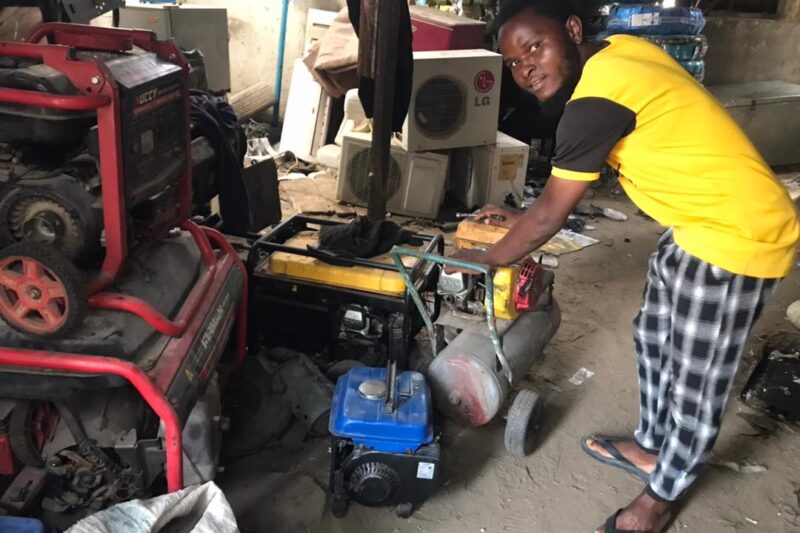Since the Coronavirus COVID-19 turned the world on its head, it is almost as if other diseases have taken a back seat. But, after a decade of armed conflict, and now combined with the pandemic, severe malnutrition in northeast Nigeria remains a major problem, especially among infants and young children.
Child-bearing women were also at risk because they had “very poor food consumption patterns, both quantity and nutritional quality” and often could not feed their babies.
Faced with an unusually high influx of malnourished children, Médecins Sans Frontières (MSF) – also known as Doctors Without Borders – recently opened a 200-bed hospital in the Kushari area of Damboa Road in Maiduguri. It caters for all, but especially internally displaced persons, most of whom cannot afford nutritional food or other essentials and need help from aid agencies.
They live in vastly overcrowded camps with poor water and sanitation facilities, limited supplies of hygiene necessities, such as soap and water, and often no individual space at all.
The ones who bore most the brunt of this were infants and young children who simply did not have enough to eat. Acute malnutrition weakens the immune system, making it less able to fight infections.
The United Nations International Children’s Emergency Fund (UNICEF) said the first 1,000 days of a child’s life “offer a unique window of opportunity for preventing undernutrition and its consequences”.
It said malnutrition was a direct or underlying cause of 45% of all deaths of under-five children.
Falmata Modu, a resident of Kushari, said she had taken her daughter to the new hospital where she was well treated.
“I’m relieved to have the hospital close by and they know how to treat malnutrition.”
Falmata Goni Saleh, a resident of Fori, said she had taken her malnourished son to another health institution but, although he was hospitalised, he was not given medication and was discharged.
She said the MSF’s new hospital had staff who knew how to treat malnourished children and she could already see a difference in her son.
A Fulani woman, Inna Wuro, said her daughter had been sick for a while before she took her to the new MSF hospital, where she had been well treated. She said the staff at the hospital had given her good advice and she had faith in them.
A doctor, who asked to remain anonymous, said the hospital was purposely built to look after malnourished children 18 months and younger.
Each child taken to the hospital had to undergo a malnutrition test. If the child proved positive, their mother would get the necessary supplements.
This included “Ready-to-use Therapeutic Foods” (RUTFs), which were a type of therapeutic food used in community-based treatment for uncomplicated forms of severe acute malnutrition. Typically, RUTFs are made from peanut-based paste, oil, sugar and powdered milk, with added vitamins and minerals.
Action Against Hunger, a global humanitarian organisation that acts against the causes and effects of hunger, said RUTFs were a revolutionary development in treating malnutrition.
Before RUTFs were invented, families would need to take their children for inpatient treatment at clinics or hospitals and they would have to stay there until their child recovered. Now, under the supervision of community health workers, families could safely and effectively treat children at home with RUTFs.
This was particularly useful for internally displaced persons who did not always have cooking fuel or facilities to make food.
The organisation said RUTFs had saved hundreds of thousands of lives.
- In an analysis by the United Nations Food and Agriculture Organisation (FAO) over the period from September 2020 to August 2021, it said more than 1 million children in northeast Nigeria were expected to be acutely malnourished, including more than 600,000 facing severe malnutrition and who might die if nothing was done. More than 123,000 pregnant or lactating women were also expected to suffer from acute malnutrition.
It said the levels of malnutrition were aggravated by ongoing conflict in the region, food insecurity, poor water and sanitation (WASH) conditions, high morbidity, and poor infant and young child feeding (IYCF) practices. The poor IYCF practices were evidenced by the extremely low prevalence of children having minimum acceptable diets (MAD), which were 1% in Adamawa, 0.9% in Borno and 0.4% in Yobe states.
- According to the MSF, nine children die every minute because their diet lacks essential nutrients.
When children suffer from acute malnutrition, their immune systems are so impaired that the risk of death is greatly increased, it said.
- According to the World Health Organisation (WHO), malnutrition is the single greatest threat to the world’s public health, with 178 million malnourished children across the globe.
The critical age for malnutrition is from six months – when mothers generally start supplementing breast milk – to 24 months. However, children under five, adolescents, pregnant or breastfeeding women, the elderly and the chronically ill are also vulnerable.







